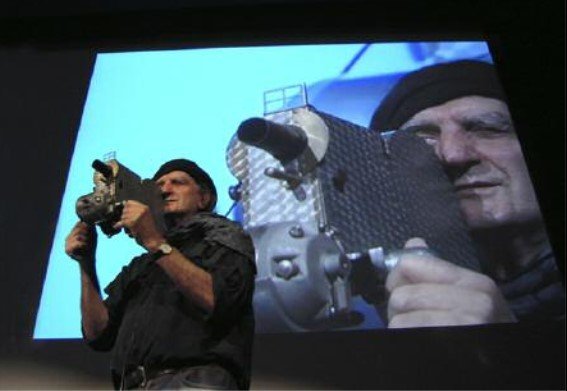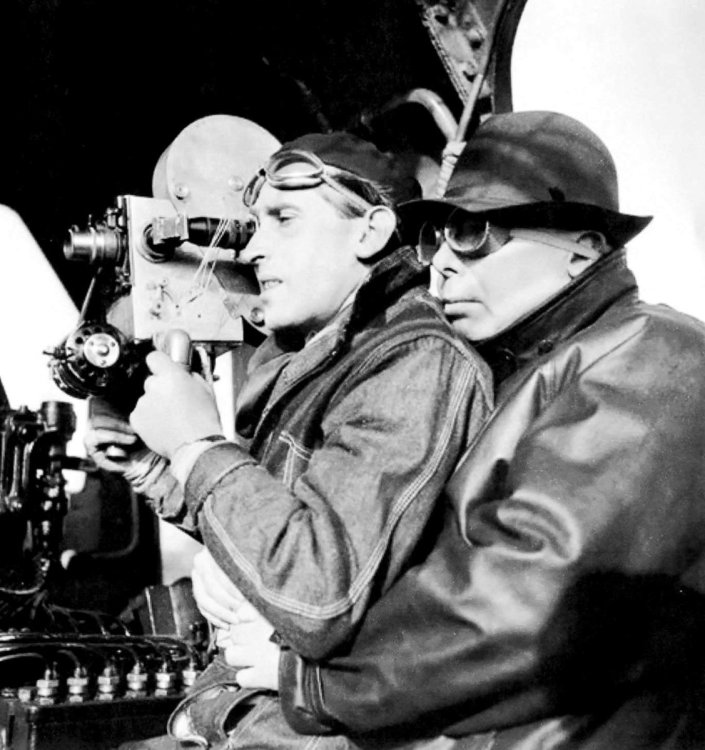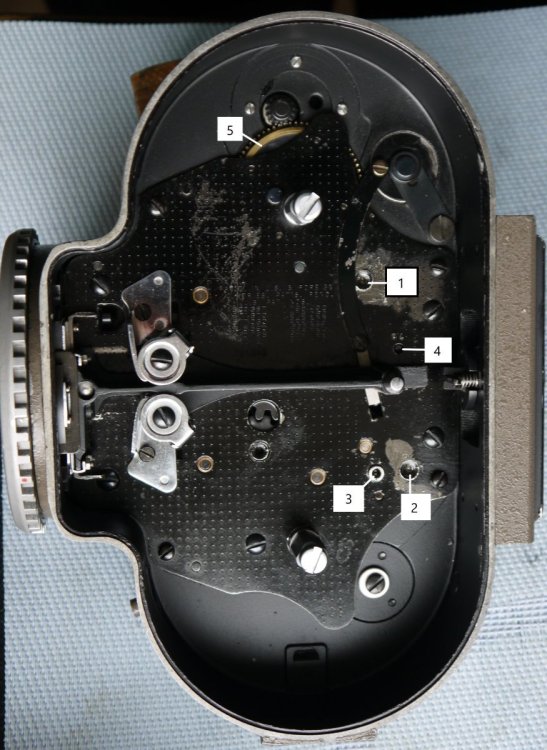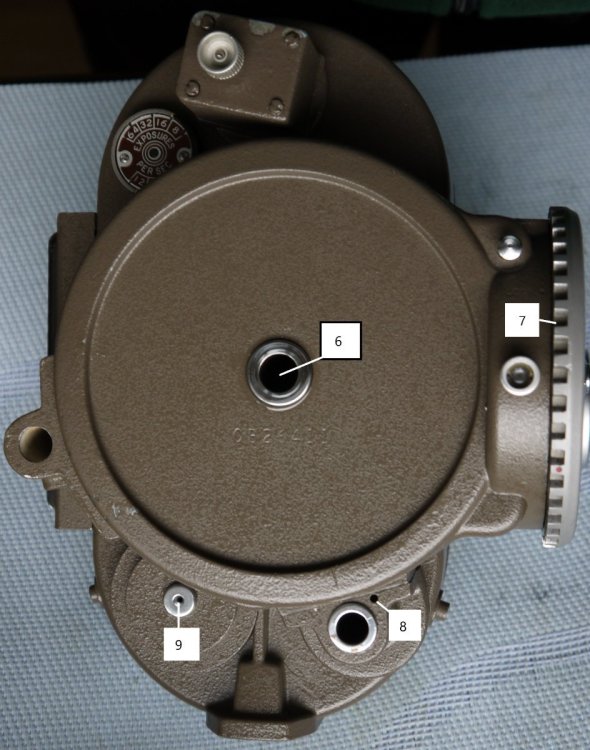-
Posts
2,588 -
Joined
-
Last visited
Everything posted by Simon Wyss
-
https://www.filmvorfuehrer.de/topic/24892-darf-ich-vorstellen-kiew-16-alpha-die-leichteste-und-lauteste-federwerk-reflexsucherkamera/#comment-278877 Pretty straightforward, screws in film chamber. Why don’t you first remove the handgrip?
-

Standard 16mm film camera lenses
Simon Wyss replied to Stephen Perera's topic in Lenses & Lens Accessories
As always, a well maintained triplet gives better images than an out-of-whack complicated or zoom one. The very sought-after Hypar by Goerz are triplets, nothing more than a Trioplan by Meyer or a simple anastigmat from Wollensak. Bausch & Lomb made triplets and Zeiss Triotar is a three-glass lens, too. The classic set of primes on a Paillard-Bolex H-16 are three triplets, the YVAR 25-2.5, the YVAR 15-2.8, and the YVAR 75-2.5 or -2.8. When working with black-and-white film and filters triplets can be rewarding because yellow filters cut off ultraviolet, violet, and blue light. Almost all triplets are optimised for the spectral range from green to red, not blue. Result: tack sharp pictures. The Tessar design is unique with tele lenses, you have that snap-in focus, as photographers liked to say. The other interesting four-glass construction is the Petzval lens. That one got modernised again and again. The B. & L. Animar 26 mm, f/1.9 is a young Petzval, very sharp in the center. The Kodak one-inch anastigmat, f/1.9 from the twenties is a descendant of the 19th century Goerz Celor but slightly asymmetric. Strong character My favourite focal length is the double of normal, that is two inches or 50 mm for 16-mm. film. The TTH Ivotal are four-glass designs of stunning quality, the 2-inch being a champion. Rare are Gundlach Radar and Krauss, Paris. Krauss had a 25 mm, f/1.8 Rexyl. No idea of its construction. Hermagis Perlynx is another important four-elements lens offering even illumination across the image. Finally all the Ernostar cine lenses, a group of phantastic four-glass optics. Examples: Eumigar on Eumig C 16 or the Schneider Xenoplan- 1 reply
-
- 1
-

-
Yes, the reversal films got adapted to a potassium permanganate bleach bath instead of a potassium dichromate one. Let’s hold apart Tri-X reversal, abbreviation TXR, and Tri-X negative film, abbreviated TX by Kodak. Equally Plus-X negative and Plus-X reversal, PXN or PXR
-
Yes. Only synchronous electric machines do jump-start. The strength of such a material depends strongly on its state, I mean whether it’s dry or greasy or oily, and wear. From what I’ve found after a quick research I’d say 2900 psi. 1 megapascal equals 145 pounds per square inch. https://aseckunststoffen.nl/wp-content/uploads/2016/05/Datasheet-AS-PF-CP-206.pdf
-
https://www.camera-manual.com/elmo-110-r-manual-3385 https://van-eck.net/en/product/elmo_super_110_-super8_camera-_user_manual-_languages-_english/ lazybone
-
You have several ways of winding the spring. Usually one employs a key. The first key on Filmo and Eyemo is simple. Later came a ratcheting key that lets you wind like a watch. The crank is there for fast winding but you must hold the camera firmly. Beneath the spring bulge of the camera body you can insert the rewind crank. It bears a numbered disc that can be adjusted rotationally. The Filmo crank counts to 20, the Eyemo counts to 8. You can turn the mechanism by hand indefinitely forward, there is a clutch inside that allows for. You can turn backwards until the spring is taught. A pair of stop gears brackets the run time. You have access to them in the film chamber center through a round opening. While putting tension on the spring as if you were winding it up you can slide the lower gear axially free of the other one with a screwdriver. That way it is possible to reset pretension. Beware of tightening the mainspring too much. Set governor at lowest speed.
-
Farthest left is a Le Blay, very awkward. Next, in the hands of the smoker, a Graflex. I think to see Horseman press cameras. Then we have a Newman & Sinclair Auto and to the right an Eyemo 71-C. See Jean-Pierre Beauviala demonstrate the use of the Cinex of Bourdereau: From Renoir’s La bête humaine, 1938:
-
From what I can read and see you have the second reflex model, that is with the variable shutter. I call these RX-2 because I start to count with 1 and the first or RX model doesn’t have a VS. REX-3 would be the first series with the big base, REX-4 those with the 1-1 shaft on the outside for the ESM, and REX-5 is the magazine model. Yes, the motor is a late one with the rear hand knob plus reverse. All the best to your wife and everybody filming.
-
I don’t mean you but many people who have less technical interest in H cameras. It’s just got to be BOLEX. If I can confuse you, let me explain that the early models have the better claw mechanism, the laterally correct film guidance, a mainspring that can be rewound during runs, longer lens mount threads in the turret, and a shutter opening angle of 190 degrees. More camera than with all the younger models. Interestingly, an electric motor can be attached to them as well, it takes an additional LH fastening screw though and a different coupling bush.
-
You can’t damage the camera with the Unimotor, perhaps a roll pin in place of a solid dowel. When you let turn the motor on that one heats up. Sooner or later the motor or the clutch catches fire. 🔥 😜 It’s not professional to keep the electric motor running for the amateurish demand of not overexposed first frames. Again a clash caused by the coining Professional Amateur by Paillard, since 1936. But suum cuique, I can’t alter everybody’s expectations. What I can do is praise the Bell & Howell Filmo 70 models that afford a totally different technical approach. If we compare the H to the 70 we begin with the side finder. Bye-bye, Bolex!
-
I think this is another testimony of the many changes that were made at Paillard. When you study the service manual you see that it’s full of little things differing here and there over time. Regarding these motors I’m under the impression that out of experience somebody said the clutch or shock absorber, which it isn’t because the motor doesn’t start up like a synchronous machine, is unnecessary. We’ll make the thing straight, give it a bore here, place in a grooved pin. The argument was perhaps that the camera mechanism starts up even quicker when driven by spring force. On the other hand, to keep the electric motor turning with the camera at halt is something that only puzzles me. Maybe to produce warmth in the cold? In cold conditions I rather rely on the mainspring than a battery. For a setting of the protective clutch you need to know the shear strength of the composite gear’s toothing. Then you give it a torque about a third lower. That’s how I’d do it.
-
That’s the main group or assembly. There are ball bearings, helical gears, runners or guided posts in grooves, pivoting and reciprocatingly moving parts in plain bearings that all need at least C‘n’L. The fastest moving parts are those in connection with the motor shaft, three times faster than the main shaft. Two ball bearings with an Arriflex 16 electric motor plus the steel-ball-in-rubber-cup coupling.
-
Precisely. There’s a friction clutch or safety friction, if you want, between the rotor and the coupling. After the many years these motors have been lying around I advise that a technician cleans out the old grease, lubricates everything freshly, and adjusts the force from the spring washers. The clutch is mostly way too hard so that in case of a stall either the internal worm gear gets damaged or the pin in the camera’s drive shaft sheared off. Fun thing about the MC-17 is that it runs on AC as well as on DC.
-
What did you do to the main group?
-
There’s a number of issues. Steadiness is over the hill, you have a ligh flash in a scene, sharpness is not good overall. When you state that the lens’ iris is defunct and mistake the prism block for the pressure plate I can only say: Dom, Melbourne.
- 6 replies
-
- bolex h-16
- bolex
-
(and 2 more)
Tagged with:
-
To be very explicit: the H cameras were assembled by dozens of individuals being equipped with the tools and auxiliaries necessary for each one’s particular job. Today one technician has to perform all actions that were fragmented in the days her/himself. Many special tools are helpful and at various points fresh material, new parts, are almost indispensable. I’m thinking of the pull springs to the derailleur with older models and of the claw assembly.
-
Wild motors need to be braked to the desired speed by the mechanical governor of the camera. Different from the MST or ESM motors where we free the governor by setting the speed dial to 32 or 48 or 64 the MC-17 calls for a governor tempo. Then no flicker occurs unless the shutter is loose on its shaft or you have interference between shutter angle, speed, and an electric light source.
-
Hi, James When the first frames are in focus technical sharpness is given at the time the corresponding length of film passes by the gate. Focus going off can be caused by the film moving away from the focal plane either by not being held flat or by buckling due to dryness and or age; the lens losing the setting, either at the front or as a whole relative to the film; this would imply a mechanical weakness somewhere between lens, mount, and film; the reflex double prism moving in some fashion. Check whether the prism holder is held onto its seat by spring force, it must spontaneously fall back after being lifted only the slightest amount. When swung back and pushed upon it must not clapper. This is an uncommon issue. I suspect the climate’s influence. You were having temperatures up to 40 degrees Celsius in December. Not so fresh film can warp heavily in warm air. The effect is typical like you’re describing: film at rest is pushed flat(ter), after starting a run the open length between gate and spool is getting exposed. How old is the stock?
- 6 replies
-
- bolex h-16
- bolex
-
(and 2 more)
Tagged with:
-
A good new year! I think we fully understand what you’re about. Better times will come.
-
The bore is 1,25 mm into which centre groove pins are driven that measure 1,27 mm or 0.05" over the ridges. An alternative are rolled sheets, some call them roll pins although they’re not pins. The 1 mm size, 6 mm long, fits relatively well and is available.
-
Disagree. An Arriflex 16 register pin doesn’t move the film in any direction. Given the back and the lateral pressure it would only bend the hole edges. When one observes the cooperation of transport claw and registering claw, let me name it that for an instance, one sees that the film is completely stationary before the registering element gets in touch with it. Different story with movements such as the Bell & Howell shuttle unit or the Mitchell noiseless mechanism and descendants. There the film is only lightly under back pressure at the aperture. In a Bell & Howell 2709 or an Oxberry camera there’s practically no lateral pressure on the film at the moment of contact with the pilot pins.
-
More or less, within a couple years, sometimes precisely. It depends on the model.
-
The earliest 71-K are from 1937, so your camera could be 87 years old. If the aperture is off center, it’s from 1939 or younger. Still, the mechanism can use a service, the mainspring looked after. Here are the oil spots of a Filmo 70, you can compare your model to. upper governor bearing, one drop lower governor bearing, one drop intermediate gear, one drop governor drive, two drops counter, one drop stop gears and first drive gear, six drops each 5,000 feet of film turret center, main group, one or two drops rewind crank shaft, one drop magazine drive pulley, one drop










